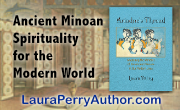All Our Relations: Pagans and the more-than-human world.
For aware Pagans the Sacred encompasses us all, rivers and mountains, oceans and deserts, grasses and trees, fish and fungi, birds and animals. Understanding the implications of what this means, and how to experience it first hand, involves our growing individually and as a community well beyond the limits of this world-pathic civilization. All Our Relations exists to help fertilize this transition.
The Old Gods are with us always: Mictcacícatl, Santisima Muerte, and Day of the Dead
One November 2, the Day of the Dead, I went to the Taos Inn to hear a talk by local Taos artist, writer, and all around remarkable woman, Anita Rodriguez. It was fascinating and I asked whether I could reproduce it here at Witches and Pagans, She graciously agreed, and asked whether I could also share her website, where people can see and perhaps purchase her work. (I love her work- she did two paintings for me a while ago.)
__________________________________
Anita Rodriguez on the meaning of Day of the Dead for us today, Day of the Dead, Taos Inn, Nov. 2, 2016.
Before I begin my talk I want to show my respect for the literally hundreds of notes people left on the altar in the library behind me. That altar was dedicated to the Santo Nino, the patron saint of prisoners, and was intended to raise consciousness about mass incarceration. I provided post-it notes and pens so people could leave prayers for prisoners. With art and a simple ritual I hoped to do my grain-of-sand part for positive social change. But during the months, people began leaving prayers for all kinds of things, for world peace, for personal healing, for forgiveness, to declare love, to remember someone they lost, for political causes and for the earth. They accumulated and accumulated, they piled up and hid the altar. This jar is jammed and every piece of paper, napkin, luggage tag and post-it represents a prayer, someone’s personal thoughts and hopes. So I want to burn them here to show my respect, and let all these thoughts be carried by smoke on this special night, when the ancestors are close. I don’t know what provoked so many people to participate, I really don’t. But maybe it says something about a widespread spiritual need to engage in ritual acts, to pray, to direct attention and consciousness.
*
I’m going to leave aside the interesting conversation about cultural appropriation and DOD. To begin with that would be closing the barn door after the cows are gone. And second but not least – we all die. Whatever our cultures and however we name death, we all must go through that mysterious door. No earthly power can colonize death or claim exclusive intellectual property on the universal.
What I think is more interesting is to ask why DOD has taken such hold here in the U.S., why has it captivated the imagination of non-Mexicans and become a major festival. It’s a big deal in San Francisco, a real carnival. Dia de Los Muertos has crossed the border and Mexicanized Halloween, altars pop up everywhere, in houses where not a word of Spanish is spoken, in art galleries, on the street. Paper cuts, sugar skulls, toy skeletons wearing sombreros flood the market.
The roots of Dia de los muertos are indigenous, and this special time has been honored all over Mesoamerica for over a thousand years. In Mexico the details differ from place to place, according to the colloquial traditions of Mexico’s many tribes, but the whole country, all classes, participate. The man who introduced Jungian psychology to Mexico, Manuel Arcevdo, theorized that the collective unconscious of Mexico is indigenous. I am not alone in believing that Mexico is Indian country, based on the experience of living there for 15 years and growing up on the edge of the reservation here in Taos.
The old Mexica gods still inhabit their land, they have just dressed up like Catholics, disguised themselves as saints, retreated to private domestic altars, morphed into popular art. They are living archetypes in the collective psyche of a Mestizo country, imbedded in our DNA, in living traditions, and the contemporary cultural environment. This is a tzonpanli, or skull rack, filled with the skulls of sacrificial victims. Human sacrifice, like slavery, has just morphed into euphemisms like “collateral damage” and “mass incarceration,” but we still practice them. It is well known that in the Maya and Mexica world, human sacrifice was necessary to keep the world functioning. Nature was not conceived as something inanimate over which humans had been given dominion, but a conscious cyclical matrix in which humans were obligated to “pay back” what they consumed. By the time Cortez arrived the sacrifices had become the tools of the Mexica imperialist state, and other city-states were forced to pay tribute to Teochitlán in sacrificial victims. War was conducted for the purpose of feeding the hungry gods, to capture warriors for the sacrifices.
Ancient Mesoamerican people’s fundamental relationship with nature was one of obligation, of responsibility - not dominion and control. The real Americans on this continent still carry a profound sense of ecological obligation. But as psychology has taught us, trauma can have two effects. Either it turns the abused into an abuser, or it stimulates compassion and becomes consciously non-violent. All people of color have been and are abused in our country. But native people have suffered the longest. The miracle is not only that they have survived with their languages, dances and songs intact. But that somehow, in spite of everything that has been done and is being done to them, they have managed to maintain non-violence at Standing Rock.
The collision between two fundamentally different worlds is reaching a climax in our time. There is a war between people that see the earth and human beings as disposable objects to be sacrificed for money, and people who see Nature as sacred. Indigenous people still own and protect 80% of the planet’s biodiversity. In fierce battles against giant corporations not only on reservations in this country but throughout the Americas they are fighting Goliath to protect the pieces of earth left to them, the only places they have left to go. Science has now proven that we are part of a cyclical matrix that is necessary for our survival. Indigenous people, who are 2% of the population, have never lost this fundamental knowledge. It comes down to common sense. We can’t live without water. Unlimited consumption leads to death.
Before you settle into the comfort of thinking that our empire is more humane than the Aztec’s, because we don’t have human sacrifices for our fiesta - remember the 7 countries we are bombing as I speak. Tonight, on day of the dead, remember the estimated 20 million who have died in our wars this century. Remember the genocide of the Native peoples with which we began our history, and the ancestors whose graves were desecrated Sept 3 at Standing Rock. Remember those of our own warriors we have sacrificed.
Perhaps the old god, the archetype of death we call Saint Death in English is not a dead superstition, but an image imbedded in the consciousness of all humans who know they are going to die. Perhaps the only way she can break through the cacophony of our materialistic life so disconnected from the earth is through art, the popular arts of the people and old traditions.
The goddess and god of the Mexica underworld, the gods of death, were Mictcacícatl and Mictantecuitli. They were major deities in the Mexica pantheon. Quetzacuatl descended into the dark and fearsome land of the dead, and begged the gods of death to give him the bones of the human race so he could re-seed the world with people. He had to promise they would all die someday and Mictcacícatl and Micitnatecuitli would get their precious bones back. But the gods of death are tricky, and they dug a trench in his escape path and when he fell into it some of the bones were chipped, which is why humans came out different sizes.
The church tried for 500 years to wipe out the cult to the goddess of death, and finally gave up and absorbed her as la Santisima Muerte, who protects her devotees from violence and gives a good death. These votive cards are sold in churches all over Mexico. Mexican call her by many names – La Satisima Muerte, la Pelona, La Flaca, La Madrina, La Nina Blanca, doña Sebanstiana – but her true identity persists.
In 2006 President Calderon began his War on Drugs, and since then an estimated 30-40 thousand people have died or disappeared. NAFTA destroyed subsistence agriculture and the drug trade became Mexico’s biggest employer. The country was plunged into a drug war, whole towns burned, states were abandoned, businesses had to pay protection, and with typically Mexican black humor people claimed that even la llorona was afraid to go out at night. Everybody was a victim or had a friend or relative who was. The whole country has PTSD.
Suddenly, shrines to La Santisima sprang up all over the Republic. Along the highways, in the mercados, in store fronts and in people’s windows. There were processions, TV testimonials, masses, whole magazines devoted to the cult, self-appointed bishops. A 40-foot hi statue was erected to her in a barrio in Mexico City.
Like an underground river in the collective Mexican psyche, Mictcacícatl sprang into flood because her people needed her. She is the special patroness of the marginalized, of criminals, the poor, those who are disillusioned with the government and the church. Given the professional risks and grisly violence of the drug war her protection was especially sought by drug dealers. Because of her association with organized crime, the police began to tear down her shrines, her devotees went back underground, I could no longer buy little silver skulls for my nicho doors, and even the mention of her name began to make taxi drivers nervous. The very repression of the cult was testimony to the power of living archetypes. The myths and archetypes of cultures and countries drive their destinies. Not only death, but a pantheon of other images exist in the consciousness of humans, just like livers, hearts and brains, we all have them. Take Kali, and compare her to Coatique, her Mexica counterpart. This statue is in the Museum of Anthropology in Mexico City. It weight 8 tons, is 8 feet tall and when the Spanish dug it up where the Aztecs had buried it to protect their sacred objects they were so terrified they buried it again.
Let me tell you a story. I was walking across the Plaza de la Paz in Guanajuato, where I had been living for about 5 years, with this painting under my arm. It was at the height of the Santisima Muerte phenomenon. A curandero friend of mine had filled his little taller with images of la Santisima, and he wanted me to paint one for him.
Three men sitting at an outside restaurant table stopped me and asked if they could buy the painting. I explained it was already sold, and they invited me to sit down. We began talking about the Santisima cult, about the macabre murders, the decapitations and corruption, then we went on the swine flu, the ecological threat and the possibility of nuclear war. As can only happen with people you will never see again, we let each other see our fear and we shared the certain knowledge that Death was telling us through popular art and the nationwide obsession with La Santisima that threat of death was real.
The time came to leave, and I got up to go. One of the men rose and right there in the street, he gave me a formal bendición. That is a very serious ritual, something you only do on your deathbed or for someone who is going off to war. I looked around out of the corner of my eye and the waiters, the passersby were all standing with their heads bowed, people at surrounding tables were sitting quietly.
I would like to think it was the power of my painting. But it was the power of La Santisima. I have painted her many times since, and she always leaves with someone who needs her. She has been there for friends as they passed over. As she always has throughout history, like the living image she is, she changes. This is the latest one. It’s hanging in the library behind me. Now she is leaning out of the sky over the landscape below, the cold winds of space blowing her veil of stars. She is holding out the globe of our beautiful planet in an urgent gesture as if she wants us to see it, to think about how beautiful it is. At her feet there is a spring of sparkling water (I even put glitter on it) animals are gathered there. And a lone woman stands with her bare feet firmly on the earth, holding up an eagle feather. I call it THE WATER PROTECTOR.
Comments
-
Please login first in order for you to submit comments





















